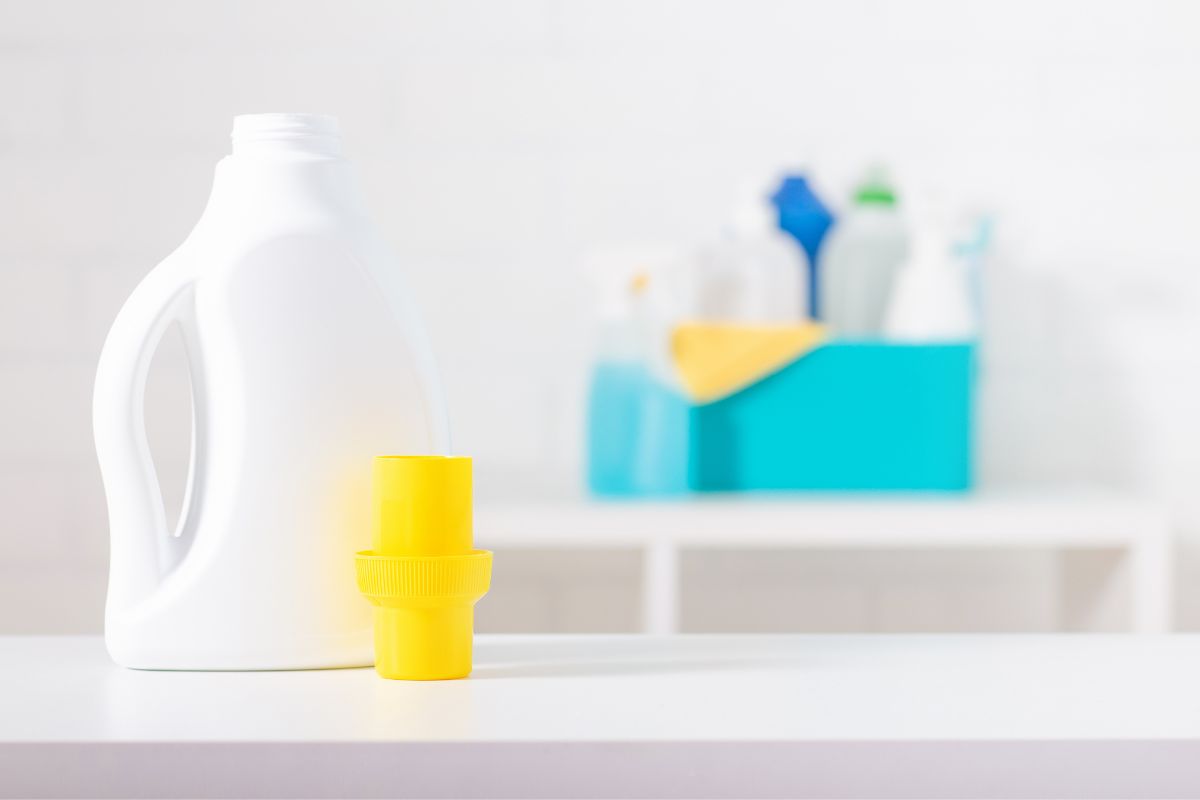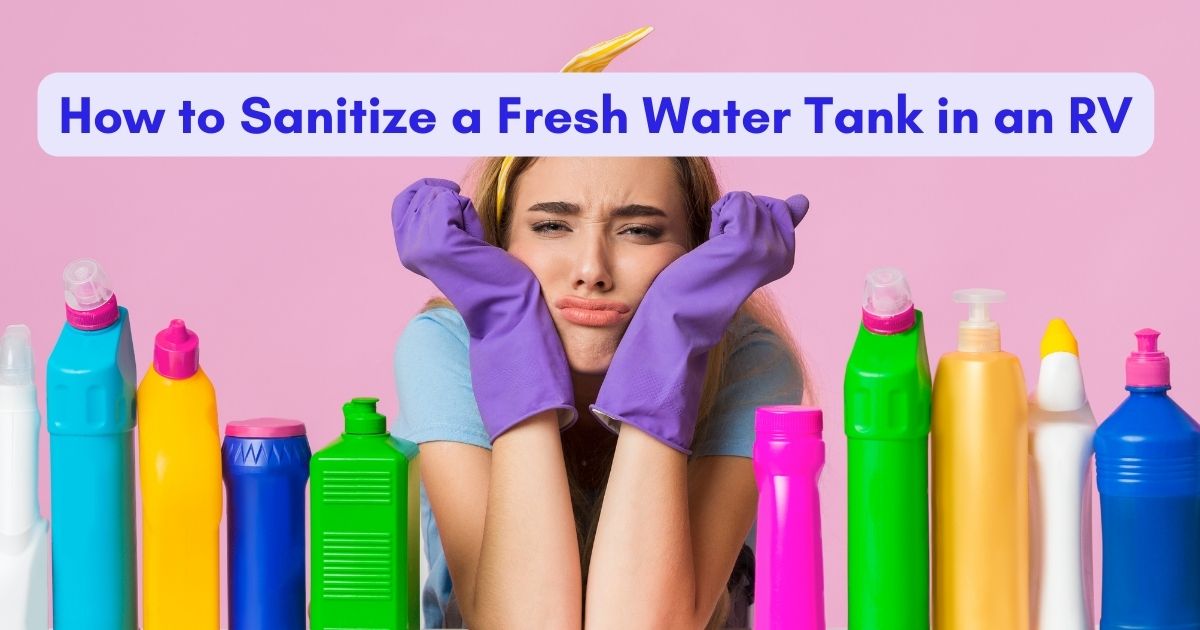What is an RV Fresh Water Tank?
An RV fresh water tank is the part of your plumbing that holds the fresh water for your home’s water supply. The RV fresh water tank is essential for your water system, and you will need to know how to sanitize a freshwater tank in an RV so you can remain healthy.
The Benefits of Sanitizing Your Tank
An RV fresh water tank is found on most RV trailers and connects to an RV’s water supply line. If you are in your RV full-time or part of the time, you need to have reliable water hookups.
It would be best if you sanitized the RV water tank to prevent the spread of germs and keep the water clean. Sanitizing the RV water tank will help keep your home clean and hygienic.
Keeping a freshwater tank clean and sanitized is important for several reasons. First, it helps protect the integrity of your home from harmful bacteria that thrive in dirty environments. Second, it keeps your water supply safe for drinking and cleaning purposes.
Other sanitization benefits include:
- Protection from bacteria and other harmful germs.
- Reduces water usage, giving you more freedom to explore.
- Consistent water pressure so your appliances can work effectively.
- Increased RV water quality, giving you and your family clean water to drink and use for bathing, laundry, and other household tasks.
- Sanitizing your RV water tank will reduce the risk of water-borne diseases and illnesses, including Legionnaires disease, cryptosporidiosis, and Hepatitis A.
- It will increase the RV’s life by keeping the inside air fresh, reducing odors, and keeping your RV water tank sanitized.
- Safer to drink, as the tank water is without contaminants with harmful bacteria that can cause illness and even death.

RV Tank Sanitization Frequency
The recommended RV tank sanitization frequency is every six months if you use the RV full time. If you are not using the RV regularly, a three months fresh water RV tank treatment helps to prevent the build-up of mold, mildew, and bacteria.
Sanitizing too frequently or not sanitizing at all can result in dirt and bacteria building up inside your tank and water supply. This can result in foul-smelling water and a dangerous environment for you and your family.
It would be best if you also sanitized the tank when you smell an odor coming from the water, or you suspect your water is contaminated.
To sanitize your tank, you will need a clean, fresh water supply.
Some think just because they don’t drink the water from your RV tank; they do not need to sanitize; this is far from the truth. It is still essential to sanitize the RV water tank to avoid skin infections due to contaminated water.
When you sanitize the RV water tank, also remember to change the filters as they are important for the removal of sand, dust, and rust.
How to Sanitize a Fresh Water RV Tank
Before attempting any cleaning, you must consider several factors: the freshwater RV tank treatment process will take time to clean and dispose of the sanitizing agents. Therefore make sure you have enough time, and you sanitize at a location away from plants and animals so as not to cause harm to the natural resources.
Find a clean water source that you will use to mix and drain and flush out the sanitizing agent from the RV water tank. It serves no purpose to use polluted water to clean your water tank.
There are several ways to sanitize your RV water tank, which are using chlorine, hot vinegar, bleach-free solution, and baking soda. However, baking soda and bleach-free solutions are not as effective as they do not contain the antibacterial characteristic of bleach and hot vinegar.
The most effective RV tank sanitizer is chlorine, which contains bleach, but you can also use hot vinegar. Let’s explore how you can use both ingredients to clean your RV water tank.
Cleaning RV Water Tank Using Chlorine
Chlorine is the most commonly used RV fresh water sanitizer. To sanitize the fresh water tank, you will need the following supplies.
- Chlorine bleach
- A bucket
- A measuring cup
- Clean funnel
- A clean water source
- An RV hose pipe
Before you start, take the following steps:
- Open the valves and drain the freshwater tank. If you are unsure how to do this, refer to the user manual.
- Turn off the hot water tank, water pump, and ice maker (if you have them) to prevent them from being damaged.
- Bypass the external water filter for the bleach to not pass through while you are sanitizing.
Step 1
Dilute bleach in water by mixing using one cup of bleach into four gallons of water. You will repeat this mix depending on the size of your water tank.
Do not use undiluted bleach to sanitize your tank, as it will damage the plumbing fittings, seals, and baskets of your RV water tank.
Step 2
Add water to the rest of the water tank until it’s full. This will ensure that you sanitize all parts of the water tank.
Step 3
Turn on the water pump to let water pass through the system and pipes. Turn on all the faucets one at a time until you can smell the bleach, and then turn them off. Don’t forget the ice maker, washing machine, and external shower.
Step 4
Fill the tank with fresh water until it overflows and leaves it to stand for at least 8 – 12 hours; the longer, the better. You can go and focus on other activities while you wait.
Step 5
Turn the faucets on again and drain the tank until it is empty. Refill and drain the tank with clean water until you can no longer smell the bleach.
Step 6
Once complete, turn on the water heater and ice makers, and your water tank is ready for use until the next sanitization. If you do not use the RV, leave the water tank empty.
Cleaning RV Water Tank Using Vinegar
Using vinegar to clean your RV water tank is a great alternative. Vinegar is a widely available standard household product and is safe to use. Vinegar is an effective agent that can kill food bacteria such as E.coli, listeria, and salmonella.
At 130 degrees Fahrenheit (54 degrees Celsius), white distilled vinegar can kill bacteria like chlorine and makes a great RV tank sanitizer. Hot vinegar will remove mineral deposits and is also more gentle to the environment than bleach.
Here are the steps to sanitize the RV water tank using vinegar.
- Turn off our hot water tank to over 130 degrees Fahrenheit (54 degrees Celsius).
- Drain the fresh water tank and the hot water tank.
- Mix half white vinegar and half water, and make at least 15 gallons (68 liters)
- Pour the white vinegar solution into the tank until it’s full.
- Turn the water pump on and open the faucets until the vinegar solution pours out of the taps. Close faucets and turn the water off.
- Switch on the heater and wait until it heats to the set temperature.
- Mount a thread adapter to the kitchen faucet, attach a garden hose to the adapter and run it to the freshwater intake.
- Turn the water pump on once the vinegar solution has heated up; this may take a while.
- Open the hot water faucet and let the vinegar solution through until the water tank fills up.
- Open the faucets one at a time and let the liquid flow until you smell the vinegar, start with the hot and finish with the cold faucets. Once complete, remove the garden hose and sit overnight.
- Drain and rinse until you see all sediments are gone, and reset the hot water tank back to normal temperature.
- Connect freshwater and run through the hot and cold RV water system until you can no longer smell the vinegar.
The sanitization process is complete, and you are ready to fill up the water tank for use.
Leave the tank empty if you are not using it, and fill it with fresh water before your trip.

How Long Does it Take to Sanitize a Fresh Water RV Tank?
A complete freshwater RV treatment will take 12 hours to allow the sanitizer to kill all bacteria and germs properly. You will need to enable the sanitizing agent to do its job; ideally, this takes between 8 and 12 hours, and the longer, the better.
Factors determining the length of time for sanitizing the RV water tank will also depend on the strength of the sanitizing agent and the size of water in your tank.
It will take 30 minutes to drain the bleach out of the water system. If your sanitizing agent is too strong, it will take longer to flush it out of the RV water system. Make sure your RV tank sanitizer is not too strong, especially when using bleach, as it will damage some components of your water system.
It will also take longer to clean a bigger tank than a smaller tank.
FAQs on Fresh Water Tanks
How Should I Store My Water Filters Between Uses?
RV fresh water tank treatment is not complete without cleaning the filters. Filters have to be stored correctly in between uses. The best way to store filters is to drain all the water, place it in a zip-top bag and place it in the refrigerator.
If you can’t put the filter in a fridge, store it in a cool dark place to prevent bacteria growth. Please do not place the filter in a freezer as it will get damaged.
Do I Need to Sanitize My Freshwater Hose?
Yes, it would be best if you sanitize your fresh water hose, do this before you sanitize your water tank. Freshwater hoses are not the same as garden hoses.
Freshwater hoses have a special lining that prevents pesticides and other chemicals from damaging the hose. You must regularly check for leaks in the line and the brass fittings.
To sanitize the fresh water hose, mix a ½ teaspoon of bleach per gallon of water; make sure the hose is completely submerged in the solution and leave to soak overnight. Drain the solutions and rinse the hose until you can no longer smell the bleach.
What’s the Best Way to Ensure My RV Drinking Water is Safe?
Here are some things you can do to ensure your RV’s drinking water is safe.
- Regularly sanitizing RV water systems, which include the hot and cold water tanks and the hose.
- Check if the water you want to connect to is suitable for human consumption.
- Use a filtration system and store your filters correctly to prevent the growth of contaminants.
- Refill your water tanks every two weeks as, over time, the water becomes undrinkable.

Should I Sanitize my RV Holding Tanks?
You should sanitize the holding tanks at least every six months if you detect a foul smell or suspect your water is contaminated to avoid the growth of waterborne bacteria and infections. Use bleach or vinegar solutions to clean your holding tanks.
The Bottom Line
Keeping a freshwater tank clean and sanitized regularly is vital for several reasons. First, it protects the integrity of your home from harmful bacteria that thrive in dirty environments.
If you have an RV, learn how to sanitize a camper water tank, it will help maintain your water supply safe for drinking and cleaning and keep you and your family safe from bacteria and other harmful germs.
